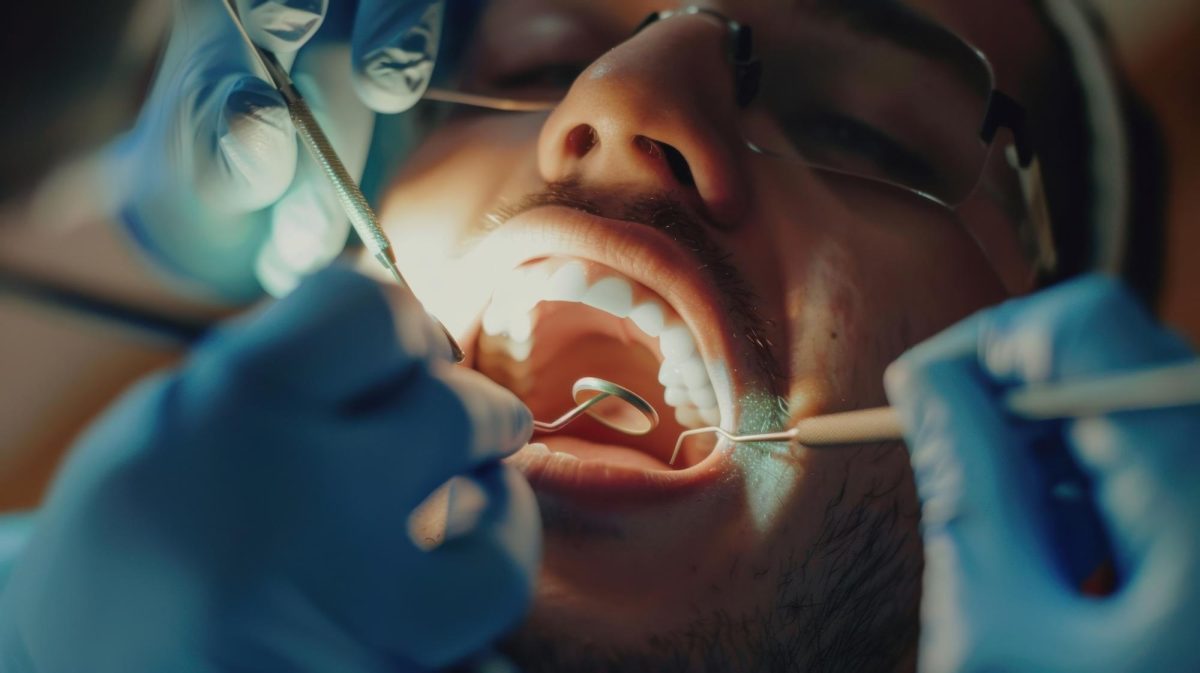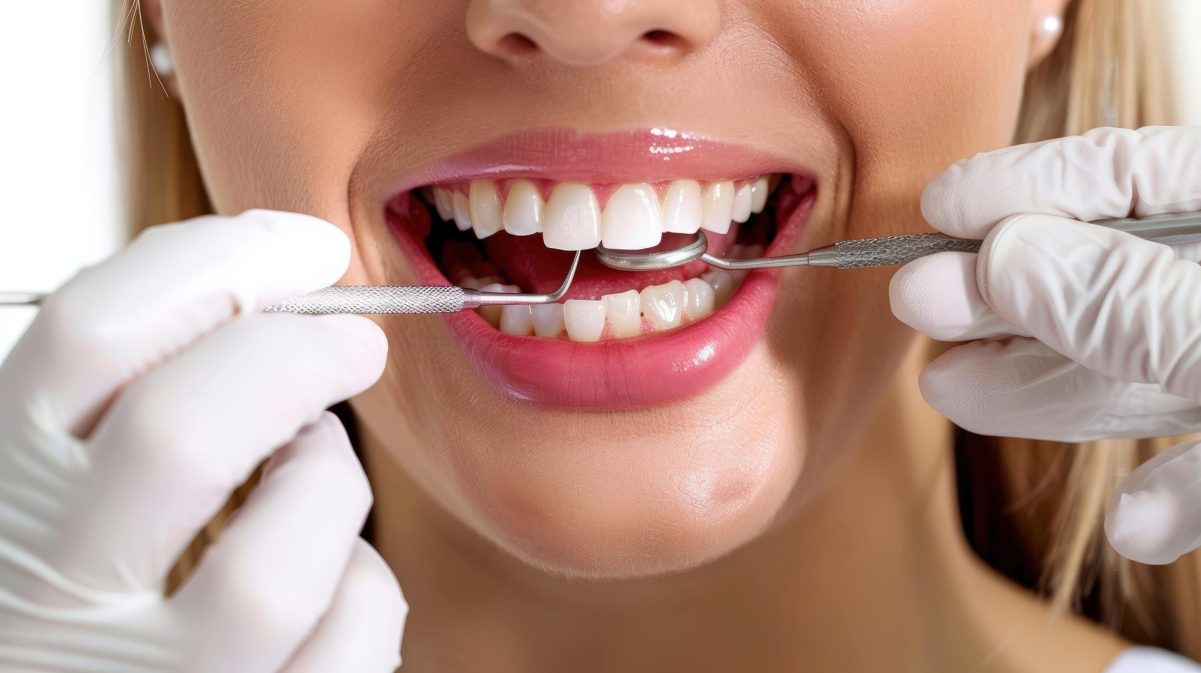FortuneSmiles Dental specializes in biomimetic dentistry, which focuses on preserving and enhancing the natural tooth structure through the use of biomimetic fillings that closely resemble your natural teeth. This innovative approach avoids damaging the tooth with invasive procedures and emphasizes the use of biocompatible materials, ensuring that no toxic substances are involved in the treatment of dental problems.
At FortuneSmiles Dental, we prioritize your health by providing advanced dental fillings that align with the principles of biomimetic dentistry, effectively treating tooth decay and dental caries while maintaining your dental integrity.
What are biomimetic fillings?
Biomimetic dentistry takes cues from nature, particularly focusing on the inherent design and composition of teeth. Unlike traditional methods, which often necessitate the removal of excessive tooth structure, biomimetic tooth repair aims to preserve healthy tooth material and reduce the risk of future complications.
In San Jose, bio-mimetic fillings utilize cutting-edge bonding techniques and tooth-colored materials that closely align with the physical and mechanical properties of natural teeth, promoting better outcomes for patients.
Biomimetic filling procedure
The biomimetic filling procedure, as practiced at Fortunesmilesdental, centers on maintaining the integrity and function of your natural teeth. This approach places a significant emphasis on preserving healthy tooth structure, with biomimetic dentistry focusing on conserving as much of the existing tooth as possible during restoration.
Rather than extensively drilling and removing decayed tooth material, dentists practicing biomimetic dentistry aim to treat and safeguard the tooth structure you still have. For instance, in situations where a tooth has a crack, instead of drilling it out, a biomimetic filling procedure would involve sterilizing the area and using a composite material to protect the tooth from further damage and decay.
Restorations achieved through biomimetic dentistry not only function well but also feel like natural teeth. Dentists at Fortunesmilesdental strive to replicate nature as much as possible, ensuring that their treatments resemble the look and feel of your natural teeth. The materials employed in the biomimetic filling procedure closely mimic natural enamel and dentin, providing a harmonious restoration.
What are biomimetic fillings made of?
Biomimetic fillings are dental materials inspired by the natural properties of teeth and their composition. These fillings aim to mimic the structure and function of natural tooth enamel and dentin.
Typically, biomimetic fillings can be made from several materials, including:
- Composite Resins:
These are often used for direct restorations. They can be engineered to mimic the color, translucency, and texture of natural teeth.
- Glass Ionomer Cements:
These materials can release fluoride, which helps to prevent decay. They bond well to tooth structure and can mimic some properties of dentin.
- Bioactive Materials:
These materials can interact with the biological environment of the tooth, promoting remineralization and potentially repairing damaged tooth structure. Examples include bioactive glass or calcium silicate-based cements.
- Nanotechnology-Enhanced Materials:
Some biomimetic fillings utilize nanotechnology to improve mechanical properties and mimic the natural tooth structure more closely.
- Hydroxyapatite-Containing Materials:
Hydroxyapatite is a natural mineral form of calcium apatite, which is a major component of tooth enamel. Some fillings incorporate hydroxyapatite to enhance remineralization.
Biomimetic dentistry emphasizes the preservation of natural tooth structure and focuses on the use of materials that can restore teeth to their natural function while minimizing the risk of further decay.

Biomimetic fillings vs. traditional fillings
In traditional dentistry, the preparation of the tooth is primarily dictated by the restorative materials and techniques used, focusing on features like retention and resistance form, often at the expense of preserving healthy tooth structure.
This results in a higher likelihood of complications such as pain, sensitivity, root canal treatments, gum recession, and fractures. Examples of traditional restorative options include full-coverage crowns made from materials like zirconia and porcelain fused to metal, along with various types of metallic inlays and fillings such as amalgam and glass ionomer.
Conversely, biomimetic dentistry takes a different approach by harmonizing an understanding of natural tooth function with cutting-edge adhesion principles to create restorations that closely mimic the original tooth. Biomimetic fillings, for example, are designed to retain as much of the intact tooth structure as possible, relying on strong adhesion instead of extensive preparation.
This not only results in restorations that are more aesthetically pleasing and functionally effective, but it also raises the question: are biomimetic fillings stronger than traditional fillings?
Evidence suggests that biomimetic restorations, which include composite fillings and partial or full-coverage ceramic options, offer enhanced strength and durability, making them a superior choice compared to traditional fillings. Ultimately, the effectiveness of these techniques hinges on a thorough understanding of the underlying science, which is crucial for achieving optimal results.
Are biomimetic fillings stronger than traditional fillings?
Biomimetic fillings represent a significant advancement in dental restoration techniques, offering numerous advantages over traditional dental fillings. At Fortunesmilesdental, we emphasize the importance of these innovative materials, which are designed to closely mimic the natural properties of teeth.
One of the primary benefits of biomimetic fillings is their enhanced strength, as they replicate the mechanical properties of natural tooth structure, thereby providing superior resistance to wear and fracture.
Additionally, these fillings demonstrate improved durability, maintaining their structural integrity over time and effectively withstanding the stresses associated with chewing.
The superior bonding capabilities of biomimetic materials further reduce microleakage, decreasing the risk of secondary decay more effectively than conventional filling options.
Aesthetic results are also noteworthy, as biomimetic fillings can closely match the color and translucency of natural teeth, making them a pleasing option for dental restorations.
Moreover, their biocompatibility ensures a lower likelihood of adverse reactions in the surrounding tissues, enhancing patient comfort.
Advantages of Biomimetic Fillings
Preservation of Tooth Structure
Biomimetic fillings focus on a conservative treatment approach, aiming to preserve as much of your natural tooth structure as possible. Unlike traditional dental fillings, which often necessitate significant removal of tooth material, biomimetic tooth repair bonds effectively with your tooth, ensuring minimal intrusion and maintaining the strength of the tooth.
Enhanced Durability
Designed to replicate the natural resilience of teeth, biomimetic fillings are less prone to fractures and breakage compared to conventional fillings. Their superior durability means that fewer replacements are needed, offering a long-lasting solution for your dental health.
Improved Aesthetics
One of the remarkable benefits of biomimetic fillings is their ability to integrate seamlessly with your natural teeth. These tooth-colored fillings are nearly indistinguishable from the surrounding teeth, making them an excellent choice for both front and back tooth restorations, ensuring your smile looks as natural and beautiful as ever.
Reduced Sensitivity
Emphasizing a comfortable dental experience, biomimetic dentistry minimizes post-operative sensitivity. As a result, you’re less likely to experience discomfort after receiving biomimetic fillings, contributing to a more pleasant treatment experience for patients of all ages.
Long-term Preservation
While addressing immediate dental concerns, biomimetic fillings also prioritize long-term tooth health. By reducing the amount of healthy tooth material that needs to be removed and using materials that match the tooth’s natural structure, they foster the overall well-being of your teeth, decreasing the chances of future dental issues.
Conservative Approach
This patient-centered approach prioritizes your dental health without unnecessary removal of tooth material, promoting a sustainable and eco-friendly model of holistic dental care.
Natural Bite and Function
Biomimetic fillings restore the natural function and bite of your teeth. Tailored to fit each tooth precisely, these fillings allow you to eat, speak, and smile comfortably, without any disruption to your daily activities.
Bio-compatibility
Utilizing bio-compatible materials, biomimetic fillings help minimize the risk of allergic reactions or other adverse effects. This quality makes them a suitable choice for many patients, including those with sensitivities or allergies, especially for those seeking biomimetic fillings in San Jose.
Alternatives to Biomimetic Fillings
While biomimetic fillings present numerous benefits, it’s important to examine biomimetic filling alternatives to ensure a well-informed choice. Here are some prevalent options to consider for biomimetic tooth repair:
- Traditional Amalgam Fillings: Amalgam fillings have been in use for many years and are renowned for their longevity. However, their silver appearance makes them less visually appealing compared to biomimetic fillings and other alternatives.
- Ceramic Inlays/Onlays: Ceramic inlays and onlays are customized restorations created in a dental lab. They offer great strength and aesthetic appeal, but the procedure often requires multiple visits and temporary restorations while waiting for the final product to be completed.
How long does biomimetic fillings it last?
Biomimetic fillings are an innovative solution in restorative dentistry, designed to closely mimic the natural properties of tooth structure. The lifespan of biomimetic fillings typically ranges from 5 to 15 years or even longer, influenced by various factors such as the specific materials used, the size and location of the filling, individual oral hygiene practices, and patient habits.
At Fortunesmilesdental, we emphasize the importance of these advanced fillings due to their ability to integrate seamlessly with the tooth structure and promote healing, potentially offering better longevity than traditional fillings. Regular dental check-ups are essential to monitor the condition of any dental restoration, ensuring that your biomimetic fillings continue to perform optimally over the years.
Conclusion
Biomimetic fillings are an innovative advancement in dental restorations, merging natural aesthetics with exceptional durability. If you’re interested in exploring biomimetic fillings in San Jose, consider reaching out to Fortunesmilesdental for more information.
These advanced fillings effectively replicate the structure and look of natural teeth, offering patients a conservative and long-lasting remedy for damaged or decayed teeth. If you are contemplating dental fillings, it’s advisable to consult with a knowledgeable dentist who specializes in biomimetic dentistry to find the most appropriate treatment plan tailored to your specific needs.
Take advantage of the advantages offered by biomimetic fillings and restore your smile with confidence while ensuring optimal oral health.

